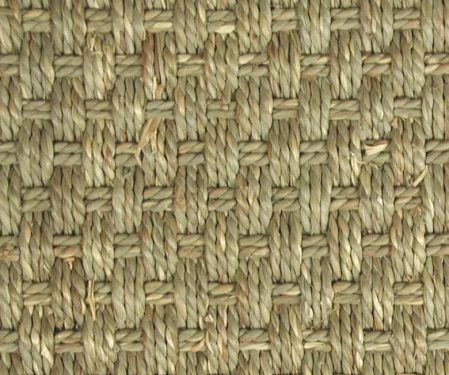Plant-based floor coverings have been used since the early days of man to make the cave more comfortable. They have never gone out of use, and today people are taking a new look at them for more than style reasons. They are biodegradable, a renewable resource, and create healthy interiors because they do not emit harmful chemicals. In addition, the purchase of a plant-based rug may help support an indigenous community that has been making these floor coverings for generations.
The finished product is architecturally neutral and textural, durable, flexible for unusual spaces, and versatile. Customers have choices in fiber, construction, shapes and sizes, and patterns and colors. Creative designers love the ease with which plant-based floor coverings and wall hangings can be customized. These products produce little static, control humidity in a room, and reduce noise.
Maintaining natural fiber rugs requires usual carpet maintenance with one big exception. Blot up liquid spills as soon as possible and vacuum regularly using a suction-only vacuum to remove dust and dirt particles that accelerate soiling and wear. And here is the big exception: NEVER steam clean or shampoo a sisal, hemp or jute rug.
Jute, abaca, sea grass, coir, and sisal are among the most popular plants used to make floor coverings:

Jute is one of the most affordable natural fibers. It is a long, soft vegetable fiber that is spun into strong, coarse threads. It was first used by tribal people near Bangladesh, but found its way to the U.S. to be woven into bags to hold cotton and is still used to make burlap cloth. India is the largest producer of jute textiles. Indigenous people make them in many colors and weaves such as boucle, Panama, and herringbone. The traditional Indian Satranji mat is a popular home decor addition;

Abaca has a long history in the Philippines where weavers use looms that haven't changed much through the centuries. Abaca was being used to weave clothes and slippers in that country long before the Spaniards arrived in the 1500s. The U.S. Navy used it in World War II, because it is sturdy and resistant to salt water. When the first samples arrived in the U.S., it was called Manila hemp, and sailors assured potential buyers, "The more you wet it, the stronger it gets." The abaca plant looks like a banana tree and is cut down to extract the trunk fibers. The layers vary in color, and the center color, cream, is the rarest and most expensive. An experienced weaver can produce a 3 by 7-foot carpet in a week.

Sisal fiber comes from the long, green leaves of an agave cactus, a close sister to the agave cactus that is used to make tequila. It originated in Mexico's Yucatan Peninsula and was used by the Mayas. Since its discovery by the Spaniards, the sisal plant has been disseminated throughout the world. Today, the major producers are Brazil and Tanzania. The fiber is extracted by crushing and beating the leaves then brushing them with blunt knives on a rotating wheel until only the fibers remain. Lower-grade fibers are used for rope and twine, while the higher grades are used for weaving into textiles. It is one of the world's most durable fibers.

Seagrass carpets are woven from natural seagrass grown in China and Vietnam. It is less susceptible to water marking than other natural fiber carpets. Seagrass is usually available in neutral colors and a popular choice for narrow rooms, hallways, and staircases. It is softer than other natural carpets and is easy to clean. It is not suitable for outdoor carpeting.

Coir is an inexpensive textile made from coconut husks. Its coarse texture has a rustic look and is sometimes woven into diamond, herringbone, and basketweave designs. Because of its coarse feel, it is great for welcome mats, but not desirable for bedroom carpeting or any room that is designed to be soft and comfortable.
Our carpet experts here at Landry & Arcari will be happy to answer your questions about carpet selection and we have a huge inventory to select from.

